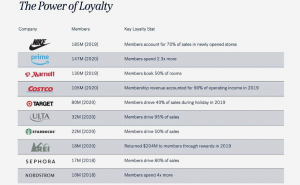By Ben Gamse, Director of Industry Insights, Direct Selling Association
The strategic importance of becoming more customer-centric is not a tightly guarded secret in retail. For example, Amazon’s mission statement says it “strives to be Earth’s Most Customer-Centric Company.” And, “customer” is the most frequently used word in Jeff Bezos’ shareholder letters going back to 1997. Recognizing the importance of customer-centricity is relatively easy. Implementing it can be the challenge.
Within direct selling, customer-centricity has been an increasingly important factor in driving growth in the last several years. It also provides opportunities for increased relevance, loyalty, and growth in a highly competitive, post-pandemic retail environment.
First, let’s review record-setting growth in direct selling in 2020, with a particular focus on customers.
According to DSA’s 2021 Growth & Outlook Survey, US direct selling set record highs in 2020 in:
• retail sales ($40.1 billion), a 13.9% Year Over Year (YOY) increase
• direct sellers (7.7 million), a 13.2% YOY increase
• and preferred customers*… DSA began collecting and reporting data on preferred customers in 2017. Since then, the count of preferred customers has increased from 17.6 million to 32.6 million in 2020 in the US. This is an 85% overall growth rate and a 19.4% increase YOY.
49% of U.S. direct selling companies are estimated to have a preferred customer program. Although this percentage has also increased over the last few years, it means that a bit more than half have not created a preferred customer program, representing a large opportunity for direct selling companies.
There are now several success stories on salesforce-customer segmentation and the benefits of preferred customer programs within direct selling, including this example from a recent DSA webinar from Tim Sanson (VP of Global Strategy and Analysis) at Herbalife Nutrition.
The DSA-Ipsos 2020 Consumer Attitudes & Entrepreneurship Study reinforces that direct selling was on-trend in the last year among consumers. According to this study, 79% of Americans are favorable/neutral toward direct selling, and those consumers surveyed value the following most about direct selling:
o “I feel good about supporting a small business” (69%); and
o “the personal service that direct sellers provide” (67%).
In addition to the success stories within direct selling, there are several examples outside direct selling that reinforce the importance of preferred/loyalty customer programs in driving growth:

Source: Forerunner
Below are three ideas to explore on how direct selling companies can create new or improve current preferred/loyalty customer programs to drive growth:
1. Customers have access to unprecedented amounts of information and countless alternatives in making shopping decisions, and loyalty programs can be an attractive differentiator
“We’ve seen that balance of power in the information age, the access consumers have to the info about the brands they want to shop and frequent. It’s shifted even further, and it’s accelerated in favor of the consumer who now shops for anything, anywhere, anytime, and does so with a different mindset from even a few years ago,” said Matthew Shay, CEO of National Retail Federation. “In this environment, understanding the customer and anticipating what they need, what they want, and then offering products, services, and the experiences that resonate with that customer is increasingly critical to the success and survival at a time when the industry is evolving so quickly.”
As the American consumer becomes more knowledgeable, expectations increase, and behavior continues to shift, it’s important for retailers to continue to meet consumers where they are and find more ways to add value.
Loyalty programs may be one such way of adding value as consumer adoption of these programs seems to be high. A Forerunner survey finds 75% of consumers belong to a loyalty program, 48% belong to 3 or more programs, and 61% are more likely to spend where they are a program member.
2. While many direct selling companies have sophisticated salesforce incentive/recognition programs in place, similar types of rewards can be a valuable retention tool for customers.
“Find opportunities for recurring low actual cost and high perceived value rewards and recognition to keep customers coming back, build brand affinity, and create an emotional connection with customers” suggests Jason Bornstein, former director of customer acquisition at Bonobos. “In a market where starting an online business is easier than ever, acquiring customers has become more expensive and competitive… The brands of the next decade will win with loyalty, not acquisition.”
3. Loyalty programs could particularly help grow Gen Z customer-base.
A survey earlier this year from digital experience company, Sitecore, found that although 80% of Gen Zers said they’re more willing to try new brands online than before the pandemic, 57% said they’re less loyal to brands than before the crisis.
71% percent of Gen Zers want the shopping experience to be personalized, and 76% said their favorite brands should reward them for their business, the survey found.
Building long-term relationships with Gen Z is vital for the long-term growth of brands. So, leveraging loyalty programs with customized messaging could be one particularly beneficial strategy of growth among a notoriously fickle cohort.
DSA’s 2021 Growth & Outlook Report (to be released later this summer) will be providing more detail on how direct selling companies can drive customer-centric growth. In the meantime, I hope you find these ideas useful to learn from peers within direct selling and from leading retailers outside of direct selling to meet consumers where they are and earn their loyalty!
*Definition: Preferred customers have signed a preferred customer agreement with a direct selling company where they may be eligible to pay wholesale prices for products/services. They are not eligible to sell products/services to others, and they are not eligible to earn.
**A version of this article appeared in the July 5, 2021 World of Direct Selling Newsletter
About the author

Ben is passionate about uncovering market trends, understanding consumer behavior, and delivering actionable insights to help make better business decisions and drive growth. For more than eight years, Ben has led the market research department at Direct Selling Association and collaborates with the Industry Research Committee, made up of leading business intelligence and analytics executives at DSA member companies to deliver market-sizing, salesforce, consumer, and other studies to meet stakeholder needs.
Previously, Ben did market research for consulting firms in Boston, MA. Ben studied economics and business administration at Boston University.
Related Articles

The Rise of Digital Experience Platforms (DXPs) in Software Development
Software development is evolving, as Digital Experience Platforms enable the delivery of a personalised digital cross-channel experience. A DXP delivers integrated content, Artificial Intelligence, and low-code rapid application development tools. It streamlines the work of developers as well as marketers.

7 Employee Benefits That Can Help Your Business Increase Staff Retention
With so many businesses vying for the attention of skilled job candidates, it’s becoming more important to look for ways to make your offerings more appealing by adding unique perks that not every employer does.

How Retailers Can Prepare for the Summer 2025 Shift
Rather than focusing on isolated touchpoints or departmental KPIs, journey management provides a way to understand where the most critical pain points lie and how to resolve them systematically across the business.

Retailers Are Drowning in Data – Journey Management Could Be the Lifeline
Rather than focusing on isolated touchpoints or departmental KPIs, journey management provides a way to understand where the most critical pain points lie and how to resolve them systematically across the business.



 for the latest news and job opportunities in retail tech
for the latest news and job opportunities in retail tech 